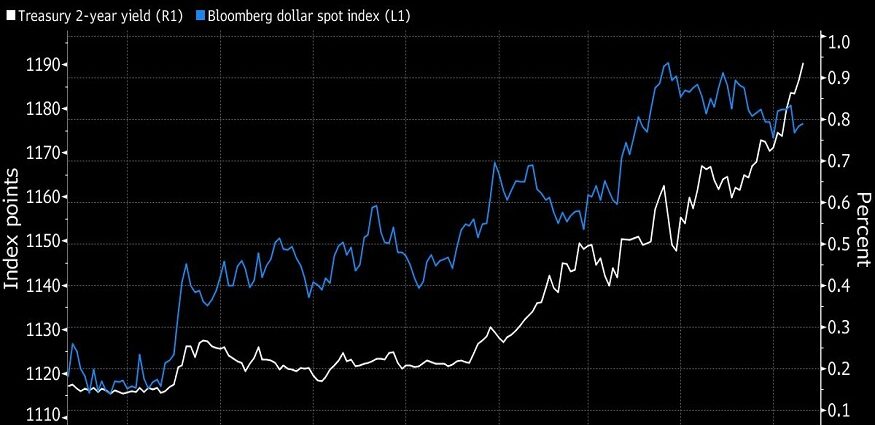The Dollar Index (DXY) is a widely used gauge that tracks the performance of the U.S. dollar against a group of six prominent global currencies, including the euro, yen, British pound, Canadian dollar, krona, and Swiss franc. While often viewed simply as a currency indicator, the Dollar Index plays a much broader role in financial markets. Its movements can send ripples through global bond yields, shape the trajectory of commodity prices, and influence trading strategies across currency pairs.
As the U.S. dollar remains the world’s primary reserve and trade currency, changes in the DXY often reflect shifting investor sentiment, interest rate expectations, and macroeconomic trends that affect markets worldwide. Understanding these interconnections is essential for informed decision-making in today’s interconnected financial environment.
What Is the Dollar Index?
The Dollar Index (DXY) measures the strength of the U.S. dollar against a basket of six major currencies: 57.6% euro, 13.6% yen, 11.9% pound, 9.1% Canadian dollar, 4.2% krona, and 3.6% franc. Introduced by the U.S. Federal Reserve in 1973 after the collapse of the Bretton Woods system, the index started at a base value of 100. Readings above or below this level reflect appreciation or depreciation of the dollar since then.
Despite its euro-heavy weighting and exclusion of emerging market currencies, DXY remains the most widely used gauge of the dollar’s global strength. It is frequently referenced by traders and policymakers to assess risk sentiment, capital flows, and expectations around U.S. monetary policy. For up‑to‑the‑minute data and tools, check the dollar index today.
The Dollar Index and Bond Yields
A strong dollar often tightens global liquidity, boosting demand for Treasuries—but this relationship isn’t always linear. Rising DXY can signal investor risk-off sentiment, sending capital into U.S. bonds and pushing yields down. Yet, when market participants are driven by expectations of tighter U.S. monetary policy, DXY and Treasury yields can both rise.
This interplay was vividly seen recently: uncertainty around the Federal Reserve’s independence led to sharp increases in U.S. 10‑year yields alongside a weakening dollar, underlining how fiscal strain and political risk can break traditional correlations.
The Dollar Index and Commodities
Since commodities are priced in USD, a stronger dollar makes them more expensive for international buyers, typically raising prices. This inverse relationship is particularly notable for assets like oil and gold. A rise in DXY can thus depress commodity prices, while a soft dollar often coincides with commodity rallies.
Recent trends—where gold and copper surged despite a relatively stable DXY—hint at shifting dynamics, often tied to alternative reserve assets or structural commodity demand, increasing interest regardless of dollar strength.
The Dollar Index and Currency Crosses
The DXY has a profound impact on FX beyond its immediate basket. As a dominant global currency, when DXY rises, pairs like EUR/USD and AUD/USD tend to fall. Price pressure from one currency affects the relative strength of others.
When investors chase yield differences—say via carry trades—DXY’s movement often steers capital flows. A rising dollar can shrink appetite for higher-yielding currencies from emerging markets, whose fortunes are tightly linked to debt denominated in USD.
Intermarket Analysis: The Bigger Picture
Understanding how the Dollar Index, bond yields, and commodities interact helps reveal broader macroeconomic trends that drive market behavior. Intermarket analysis—the study of how asset classes influence one another—suggests several recurring patterns:
- A weak dollar paired with rising bond yields often signals inflation concerns or expectations of economic overheating, which typically benefits real assets like commodities.
- Conversely, a strong dollar combined with falling yields may reflect a flight to safety, global risk aversion, or expectations of slowing growth.
These correlations are not static but evolve with policy shifts, market sentiment, and geopolitical developments. For instance, a sudden spike in the Dollar Index alongside rising yields might indicate that the Federal Reserve is expected to tighten monetary policy aggressively. On the other hand, a declining DXY with steady or falling yields can point to a dovish Fed stance, softer inflation data, or growing recession fears.
By viewing the Dollar Index as part of a larger intermarket framework, traders can better anticipate cross-asset moves, identify potential regime shifts, and avoid isolated decision-making based on a single market signal.
Strategic Takeaways for Investors
For fixed income traders, watching DXY helps anticipate capital flow trends and policy moves. Sustained dollar strength may suppress inflation expectations, disadvantaging yields.
Commodity investors should track DXY to time hedges or speculative plays—when the dollar weakens, precious metals and energy often outperform.
In FX markets, DXY-driven flows guide positioning. For example, weakening DXY tends to dampen carry trade unwinds, benefiting “risk” currencies and emerging-market assets.
Conclusion
The index that charts the dollar (dollar index today) is not merely a currency measure—it’s a compass for global finance. Whether through the bond market, commodity prices, or foreign exchange dynamics, DXY serves as a critical macroeconomic indicator. Tracking its direction offers traders and policymakers an early signal of capital shifts, inflation trends, and central bank posture. In today’s interconnected markets, understanding the Dollar Index isn’t optional—it’s essential.

